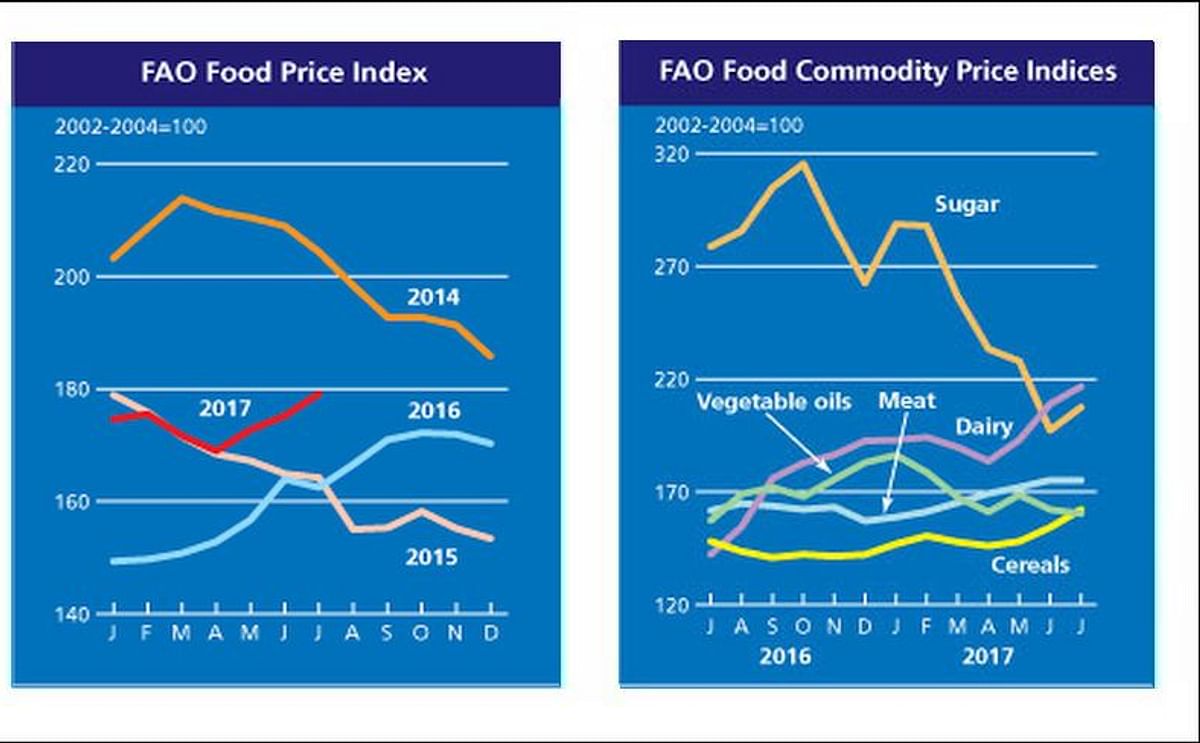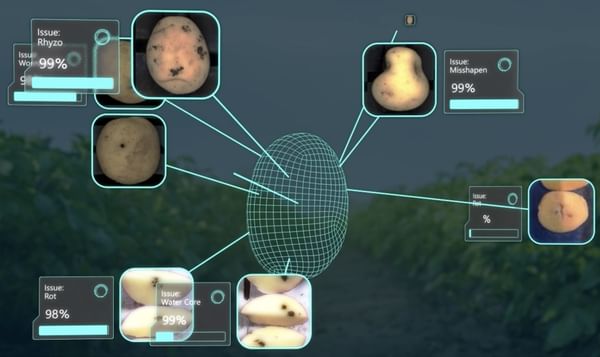The FAO Food Price Index (FFPI) averaged 179.1 points in July 2017, up 3.9 points (2.3 percent) from June and the third successive month of increases.
FAO Food Price Index up for the third month in a row

The FAO Food Price Index (FFPI) averaged 179.1 points in July 2017, up 3.9 points (2.3 percent) from June and the third successive month of increases. This latest rise put the Index nearly 16.6 points (10.2 percent) above last year’s level and at its highest since January 2015. A combination of supply constraints and currency movements provided support to prices of most cereals, sugar and dairy. Instead, meat values remained steady month-on-month, whereas the Vegetable Oil Index edged down.
The FAO Cereal Price Index averaged 162.2 points in July, up almost 8 points (5.1 percent) from June and 14.1 points (9.5 percent) from July 2016. Cereal prices have risen consistently over the past three months, driven by stronger wheat prices and, to a lesser extent, also firmer rice quotations. Wheat values rose the most in July, as continued hot and dry weather deteriorated spring wheat conditions further in North America, fuelling quality concerns, particularly for higher protein wheat. Seasonal tightness also provided some support to rice quotations, although gains were capped by a slowdown in demand. Instead, maize values remained largely steady, as support provided by a more rapid pace of foreign purchases by China was outweighed by improved weather conditions in the United States.
The FAO Vegetable Oil Price Index averaged 160.4 points in July, down 1.8 points (or 1.1 percent) from June and marking the lowest level since August 2016. The slide was driven by palm oil, the key commodity in the Index. International palm oil quotations continued to ease on good production prospects in Southeast Asia and weak global import demand, notwithstanding low inventory levels. On the other hand, world soy oil prices firmed, fuelled by concerns regarding soybean growing conditions in the United States, as unusually dry weather was reported from several producing regions. Rapeseed and sunflower oil values also strengthened, preventing the Index from falling more markedly.
The FAO Dairy Price Index averaged 216.6 points in July, up 7.6 points (3.6 percent) from June and 74.3 points (52.2 percent) above its value in July 2016. Despite this latest increase, the Index is still 21 percent below its peak reached in February 2014. International prices of butter, cheese and Whole Milk Powder (WMP) increased, but those of Skimmed Milk Powder (SMP) declined. Tighter export availabilities pushed butter prices to a new high in July, widening the spread between butter quotations and other dairy products further. While strong buying activity from Asian importers also underpinned cheese and WMP quotations, SMP prices were weighed down by slack demand and prospects of larger releases from the intervention stocks in the EU.
The FAO Meat Price Index averaged 175.1 points in July, virtually unchanged from June. At this level, the Index is 8.2 percent above July 2016 and 17.4 percent below its peak reached in August 2014. An increase in international prices for ovine meat in July was offset by downward price movements in bovine, pig and poultry sectors. In the case of bovine meat, prices fell due to weaker import demand in the United States because of increased domestic supplies. While global markets for pig and poultry meat remained well supplied, international prices could have declined further if not for strong consumer demand. Ovine meat prices rose for the fourth consecutive month, reflecting reduced export supplies from Oceania.
The FAO Sugar Price Index averaged 207.5 points in July, up 10.2 points (5.2 percent) from June, but still 26 percent below its value a year earlier. July marked the first monthly increase in sugar prices since the beginning of the year. A strong appreciation of the Brazilian real was the main catalyst for July’s rebound in sugar quotations, although generally favourable weather aided the harvest in Brazil, the world’s largest supplier, as well as crop development in Thailand and India.
The FAO Cereal Price Index averaged 162.2 points in July, up almost 8 points (5.1 percent) from June and 14.1 points (9.5 percent) from July 2016. Cereal prices have risen consistently over the past three months, driven by stronger wheat prices and, to a lesser extent, also firmer rice quotations. Wheat values rose the most in July, as continued hot and dry weather deteriorated spring wheat conditions further in North America, fuelling quality concerns, particularly for higher protein wheat. Seasonal tightness also provided some support to rice quotations, although gains were capped by a slowdown in demand. Instead, maize values remained largely steady, as support provided by a more rapid pace of foreign purchases by China was outweighed by improved weather conditions in the United States.
The FAO Vegetable Oil Price Index averaged 160.4 points in July, down 1.8 points (or 1.1 percent) from June and marking the lowest level since August 2016. The slide was driven by palm oil, the key commodity in the Index. International palm oil quotations continued to ease on good production prospects in Southeast Asia and weak global import demand, notwithstanding low inventory levels. On the other hand, world soy oil prices firmed, fuelled by concerns regarding soybean growing conditions in the United States, as unusually dry weather was reported from several producing regions. Rapeseed and sunflower oil values also strengthened, preventing the Index from falling more markedly.
The FAO Dairy Price Index averaged 216.6 points in July, up 7.6 points (3.6 percent) from June and 74.3 points (52.2 percent) above its value in July 2016. Despite this latest increase, the Index is still 21 percent below its peak reached in February 2014. International prices of butter, cheese and Whole Milk Powder (WMP) increased, but those of Skimmed Milk Powder (SMP) declined. Tighter export availabilities pushed butter prices to a new high in July, widening the spread between butter quotations and other dairy products further. While strong buying activity from Asian importers also underpinned cheese and WMP quotations, SMP prices were weighed down by slack demand and prospects of larger releases from the intervention stocks in the EU.
The FAO Meat Price Index averaged 175.1 points in July, virtually unchanged from June. At this level, the Index is 8.2 percent above July 2016 and 17.4 percent below its peak reached in August 2014. An increase in international prices for ovine meat in July was offset by downward price movements in bovine, pig and poultry sectors. In the case of bovine meat, prices fell due to weaker import demand in the United States because of increased domestic supplies. While global markets for pig and poultry meat remained well supplied, international prices could have declined further if not for strong consumer demand. Ovine meat prices rose for the fourth consecutive month, reflecting reduced export supplies from Oceania.
The FAO Sugar Price Index averaged 207.5 points in July, up 10.2 points (5.2 percent) from June, but still 26 percent below its value a year earlier. July marked the first monthly increase in sugar prices since the beginning of the year. A strong appreciation of the Brazilian real was the main catalyst for July’s rebound in sugar quotations, although generally favourable weather aided the harvest in Brazil, the world’s largest supplier, as well as crop development in Thailand and India.
Like to receive news like this by email? Join and Subscribe!
Join Our Telegram Channel for regular updates!
Highlighted Company
Sponsored Content
Sponsored Content
Sponsored Content
Sponsored Content
Sponsored Content











